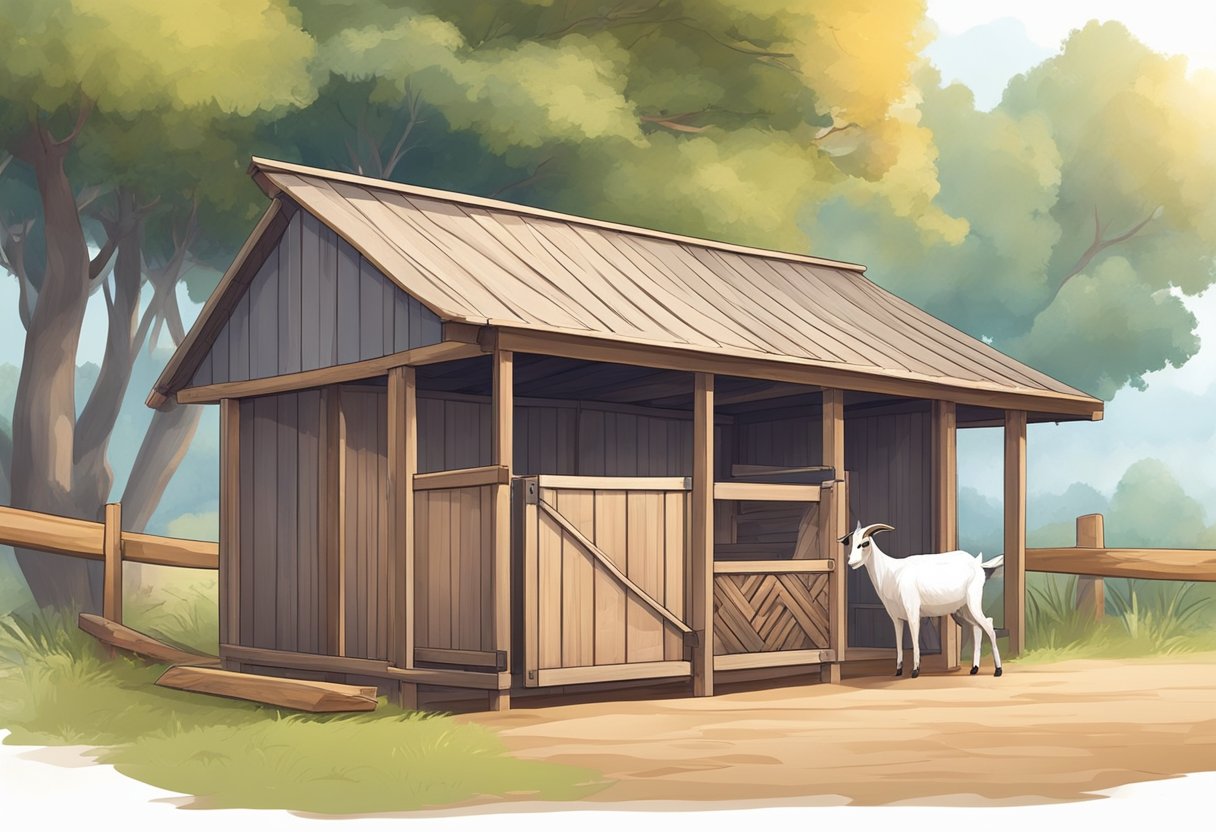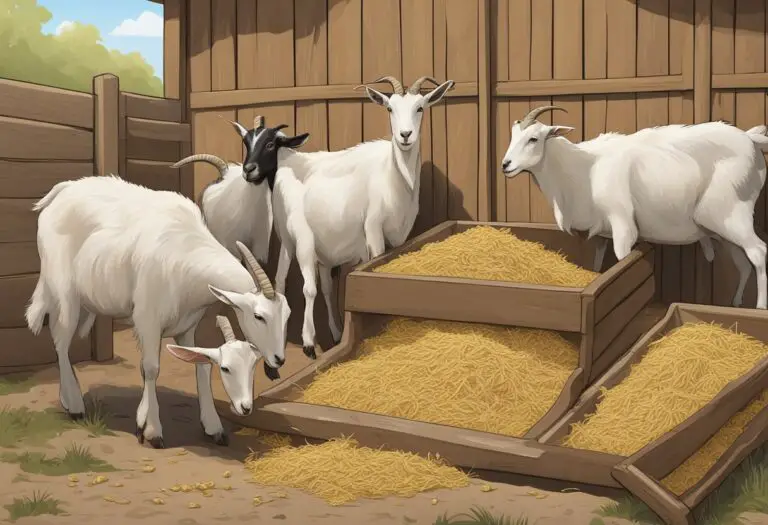How to Build a Goat Shelter: A Clear and Confident Guide
Goats are a popular livestock choice for many homesteaders and farmers. They are hardy, low-maintenance animals that can provide milk, meat, and fiber. However, like any animal, goats need a safe and comfortable place to live. Building a goat shelter is an important part of goat husbandry, and it doesn’t have to be a difficult or expensive task.
When building a goat shelter, there are a few key factors to consider. First and foremost, the shelter should provide adequate protection from the elements. This means a sturdy roof to keep out rain and snow, as well as walls or windbreaks to block wind and provide shade. The shelter should also be well-ventilated to prevent the buildup of moisture and ammonia from urine and feces. Finally, the shelter should be secure enough to keep predators out and goats in.
In this article, we will cover the basics of building a goat shelter. Whether you have a small backyard herd or a large commercial operation, these tips will help you create a safe and comfortable home for your goats. From choosing the right location to selecting materials and designing the layout, we will guide you through the process step by step.
Understanding Goat Shelter Needs

Goats are hardy animals that can adapt to a variety of climates and environments. However, providing them with a suitable shelter is essential to ensure their safety, comfort, and well-being. When building a goat shelter, it’s important to consider their unique needs.
Climate Considerations
Goats are adaptable to different climates, but extreme temperatures can be detrimental to their health. In cold weather, they need a shelter that provides protection from wind, rain, and snow. The shelter should be well-insulated and have enough space to accommodate all the goats comfortably.
In hot weather, goats need a shelter that provides shade and good ventilation. The shelter should be well-ventilated to allow air to circulate freely and prevent the buildup of heat and humidity. It’s also important to provide plenty of fresh water to keep the goats hydrated.
Space Requirements
Goats are social animals and need enough space to move around freely. The shelter should be spacious enough to accommodate all the goats comfortably, with enough room for them to lie down, stand up, and move around. A good rule of thumb is to provide at least 20 square feet of space per goat.
The shelter should also have a separate area for feeding and watering. This will help prevent the goats from trampling on their food and water and keep the area clean and hygienic.
Safety and Security
Goats are curious animals and can get into trouble if left unsupervised. The shelter should be secure and free from hazards such as sharp edges, protruding nails, and loose wires. The floor should be level and free from debris to prevent injuries.
It’s also important to provide a secure fence around the shelter to keep predators such as coyotes, dogs, and foxes out. The fence should be at least 4 feet high and made of sturdy materials such as chain link or welded wire.
By considering the climate, space requirements, and safety and security needs of goats, you can build a shelter that will provide them with a safe and comfortable home.
Planning Your Goat Shelter

When building a goat shelter, it is important to plan ahead to ensure that you have everything you need before you start. This will save you time and money in the long run, and ensure that your goats are happy and healthy.
Choosing the Location
The first step in planning your goat shelter is to choose the location. You will need to find a spot that is dry, well-drained, and away from any areas that may flood. It should also be located in an area that is easily accessible, both for you and for your goats.
Designing the Shelter
Once you have chosen the location, you will need to design your goat shelter. This will depend on the number of goats you have and the climate in your area. You will need to ensure that the shelter is large enough to accommodate all of your goats comfortably, and that it is well-ventilated to prevent the buildup of moisture and ammonia.
Materials and Tools
When building your goat shelter, you will need to have the right materials and tools. Some of the materials you will need include lumber, roofing materials, and fencing. You will also need tools such as a circular saw, hammer, and drill. It is important to make sure that you have all of the necessary materials and tools before you start building, to avoid any delays or setbacks.
By carefully planning your goat shelter, you can ensure that your goats have a safe and comfortable place to live. With the right location, design, materials, and tools, you can build a goat shelter that will provide your goats with the protection and shelter they need to thrive.
Building the Foundation

Leveling the Ground
Before starting to build a goat shelter, it is important to ensure that the ground is level. A level surface will provide a stable base for the shelter and prevent any potential damage caused by uneven ground.
To level the ground, the first step is to remove any rocks, debris, or plants from the area. Then, using a shovel or a rake, the soil should be leveled and compacted to create a firm base.
Laying the Base
Once the ground is level, the next step is to lay the base of the goat shelter. The base can be made of a variety of materials such as concrete, gravel, or cinder blocks.
If using concrete, it is important to ensure that it is level and has a smooth surface. Gravel and cinder blocks are also good options for a base as they provide good drainage and stability.
When laying the base, it is important to ensure that it is level and square. This will ensure that the rest of the goat shelter is built correctly and will prevent any potential issues in the future.
Overall, building a solid foundation is crucial when constructing a goat shelter. By following the steps outlined above, you can ensure that your goat shelter has a stable and durable base that will stand the test of time.
Constructing the Frame

When building a goat shelter, constructing a sturdy frame is crucial to ensure the shelter can withstand harsh weather conditions and keep the goats safe and comfortable. Here are some steps to follow when constructing the frame:
Assembling the Structure
- Begin by measuring and marking the dimensions of the shelter on the ground. Use stakes and string to mark the corners of the structure.
- Dig holes for the corner posts and place them in the holes. Make sure the posts are level and secure them in place with concrete.
- Cut the horizontal beams to the desired length and attach them to the corner posts using metal brackets. Make sure the beams are level and evenly spaced.
- Cut the vertical studs to the desired length and attach them to the horizontal beams using metal brackets. Space the studs evenly and make sure they are plumb.
- Repeat steps 3 and 4 for the remaining sides of the shelter until the frame is complete.
Adding the Roof
- Cut the roof rafters to the desired length and attach them to the top of the vertical studs using metal brackets. Space the rafters evenly and make sure they are level.
- Cut the roof sheathing to the desired size and attach it to the top of the roof rafters using nails or screws. Make sure the sheathing is flush with the edges of the roof.
- Install the roofing material of your choice, such as metal sheets or shingles, according to the manufacturer’s instructions.
- Add any additional features to the roof, such as gutters or vents, as needed.
By following these steps, you can construct a sturdy and reliable frame for your goat shelter.
Finishing Touches

Installing Walls
Once the frame of the goat shelter is complete, the next step is to install the walls. The walls can be made of various materials such as plywood, metal sheets, or even recycled pallets. The walls should be installed tightly to keep the shelter warm and dry. It is recommended to use screws or nails to secure the walls to the frame.
Insulation and Ventilation
Proper insulation and ventilation are essential for the comfort and health of the goats. Insulation helps to keep the shelter warm during cold weather, while ventilation helps to provide fresh air. Fiberglass insulation can be used between the walls to keep the shelter warm. For ventilation, windows can be installed or vents can be cut into the walls. It is important to ensure that the ventilation is not too drafty, as this can cause health issues for the goats.
Doors and Access Points
The final step in building a goat shelter is to install doors and access points. The doors should be large enough for the goats to enter and exit comfortably. It is recommended to use a sturdy material such as wood or metal for the doors. Access points such as windows or smaller doors can also be installed for easy cleaning and maintenance. It is important to ensure that all access points can be securely closed to keep the goats safe from predators.
In conclusion, building a goat shelter requires attention to detail and careful planning. By following these steps and taking the time to properly finish the shelter, the goats will have a comfortable and safe place to live.
Shelter Maintenance

Cleaning and Sanitation
Regular cleaning and sanitation of the goat shelter is essential to maintain a healthy and hygienic environment for the goats. It is recommended to clean the shelter at least once a week, and more frequently if necessary.
The bedding should be removed and replaced with fresh straw or wood shavings. The walls, floor, and roof should be swept and scrubbed with a mild disinfectant solution. It is important to remove any feces, urine, or other debris from the shelter.
Regular Inspections
Regular inspections of the goat shelter are necessary to ensure that it is safe and secure for the goats. Inspect the shelter at least once a month, and more frequently if necessary.
Check for any signs of damage or wear and tear, such as cracks in the walls or roof, loose or broken boards, or holes in the fencing. Make sure that the doors and windows are secure and functioning properly.
Repair and Upkeep
It is important to repair any damage or wear and tear to the goat shelter as soon as possible. This will prevent further damage and ensure the safety and well-being of the goats.
Replace any broken or damaged boards, repair any cracks or holes in the walls or roof, and replace any damaged fencing. Regularly check and maintain the hinges, latches, and other hardware on the doors and windows.
By following these simple steps for shelter maintenance, goat owners can ensure a safe and healthy environment for their animals.







